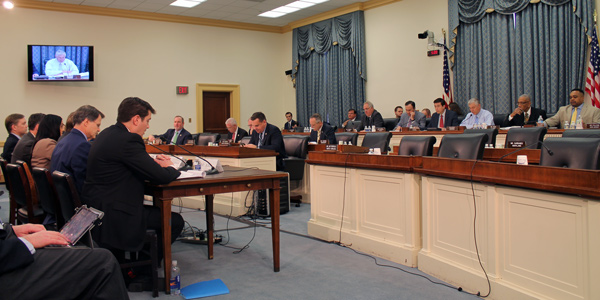By Michael Brooks
WASHINGTON — The Market Monitors for CAISO and PJM told a House subcommittee Wednesday that their respective financial transmission rights markets are significantly flawed and need fixing, although they stopped short of asking for congressional action.
Appearing before the House Energy Subcommittee, Eric Hildebrandt, director of CAISO’s Department of Market Monitoring, said electricity ratepayers in RTOs/ISOs nationwide are not receiving the full amount of congestion revenues as intended, losing more than $400 million a year instead.
After allocating an initial round of FTRs to load-serving entities that use the instruments as a hedge, RTOs auction off additional FTRs to third parties, typically sophisticated financial entities seeking to speculate on the potential to collect high rents from congested transmission segments.
“Unfortunately, revenues that ISOs collect from auctioned FTRs are consistently much lower than what the ISOs pay out to entities purchasing these FTRs,” Hildebrandt said. “This makes FTRs highly profitable for financial entities, but these profits directly reduce the congestion revenues that would otherwise be refunded back to transmission ratepayers.” He said that ratepayers only receive 52 cents in auction revenues for every dollar an RTO/ISO pays out to FTR holders, representing a nearly 100% profit for buyers.
Hildebrandt repeated his call for grid operators to end FTR auctions, a proposal he first made in CAISO a year ago. (See CAISO Monitor Proposes End to Revenue Rights Auction.)
In written testimony, PJM Independent Market Monitor Joe Bowring explained his RTO’s auction revenue rights construct before echoing Hildebrandt’s criticism.
“The current ARR/FTR design does not serve as an efficient way to ensure that load receives all the congestion revenues or has the ability to receive the auction revenues associated with all the potential congestion revenues,” Bowring said. “The goal of the ARR/FTR design should be to return 100% of the congestion revenues to the load. But the actual results fall well short of that goal.”
Opposing Hildebrandt at the hearing was TPC Energy CEO Noha Sidhom, appearing on behalf of the Power Trading Institute.
“The problem [in CAISO] is not with the FTR product; the problem is with the market design,” Sidhom said. “They’ve got significant modeling issues. … There’s something wrong with their pricing model. Also their outage scheduling is a real problem.”
Sidhom said that more than 50% of network outages are not identified in time to be modeled in the ISO’s FTR auctions. These problems result in inadequate revenues to ratepayers, but “you absolutely need the auction, because the auction is how you actually price the allocated rights.”
“It’s absolutely incorrect that the allocated FTRs are priced based on the auction,” Hildebrandt responded. “They’re allocated out, load-serving entities hold them and they get paid the congestion revenues.” Those who purchase FTRs through the auctions pay nearly half the price, and “the payout directly reduces the pot of congestion revenues that otherwise get fully refunded back to transmission ratepayers,” he said
He also disputed that the problem was unique to CAISO, saying it exists in every RTO/ISO in the U.S., although he admitted it is more severe in California. In his letter to the subcommittee, Bowring said that PJM ratepayers have missed out on more than $1.7 billion in congestion revenues over the last seven planning cycles.
The hearing was the latest in the subcommittee’s “Powering America” series, which has included discussions on reliability in the wake of a severe hurricane season, consumer advocates in energy markets and the Public Utility Regulatory Policies Act. Several congressmembers at the hearing admitted they were unfamiliar with FTRs and other virtual transactions, asking for basic explanations of their role in electricity markets.
The panelists also included Red Wolf Energy Trading CEO Wesley Allen, PJM General Counsel Vince Duane, former FERC General Counsel Max Minzer and Chris Moser, senior vice president of operations with NRG Energy.






